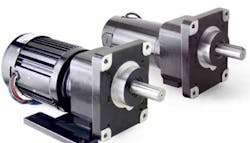Some custom motor work can be relatively inexpensive, but not all of it. “It is easy to change the number of winding turns. Changing the lamination stacks is a different story,” says Terry Auchstetter, business development manager for Bodine Electric Co. in Northfield, Ill. “And it is simple to change mechanical features like bolt patterns if they stay within the envelope of the existing bracket casting. Of course, if you need an 8-in.-diameter bolt circle when the casting has only a 6-in. diameter, obviously you’ll need a new casting.”
Auchstetter is speaking from experience: Some 70% of the fractional-horsepower motors Bodine makes are customized in some fashion. Other things to keep in mind if the need arises for a custom electric motor: “A stock product is off the shelf and the lead time is a day. A lot of engineers don’t understand that when you get into custom work, the price is higher and the lead time goes into weeks,” Auchstetter says.
Most of the customization requests Bodine sees are in operating voltages, mounting configurations, the addition of accessories, and wiring. “It’s becoming more common to use motors in remote locations to handle jobs such as tracking the sun with solar cells. Motors that work from the 12-V supplies used in those arrays are a special order for us,” says Auchstetter.
Special mounting configurations are another frequent source of customization. “It is often easier to mate with a gearbox or pump by modifying the motor mounting holes rather than by adding an adapter,” he explains. Similarly, it may be advantageous to add encoders, brakes, terminal blocks, or other ancillary components when the motor is manufactured rather than later on when it is installed. Motor wiring gets modified a lot as well. “Medical equipment often has its own standards for EMI and related factors, so wiring for motors in that area often need extra shielding and ferrite beads,” says Auchstetter. Other wiring specials may include special connectors, differing wire lengths, and custom-configured wiring harnesses.
Resources: Bodine Electric Co.
About the Author
Leland Teschler
Lee Teschler served as Editor-in-Chief of Machine Design until 2014. He holds a B.S. Engineering from the University of Michigan; a B.S. Electrical Engineering from the University of Michigan; and an MBA from Cleveland State University. Prior to joining Penton, Lee worked as a Communications design engineer for the U.S. Government.
